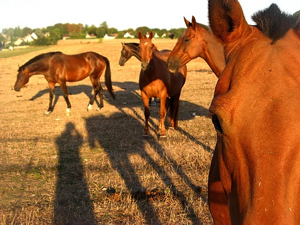
Source: PhotonQ-Similarity but all Different, PhOtoOnQuAnTiQuE, Flickr
Before you try answering sample test questions about these two texts, brainstorm some similarities. For the questions that follow, see if you can select whether the stated quality or condition is similar or not in the two texts “A narrow fellow in the grass” and the excerpt from “Walking.”
1. Both texts involve animals behaving instinctively as wild animals.
Similar
Correct! The snake “wrinkles and is gone,” escaping from the human presence. This is the behavior of a wild creature rather than a domesticated one that would not be afraid of humans. Undisturbed by humans, the cattle also exhibit wildness when they frisk about on the hillside like a herd of deer.
Not similar
Try again.
2. Both texts involve animals being compared to other animals that are “wild.”
Similar
Correct! The snake is compared to “several of nature’s people,” where “nature’s people” means other animals. We don’t know which other creatures the poet means, but the comparison suggests that she reacts very differently to snakes. The cattle are primarily compared to deer, buffalo, and the “supple cat tribe”—all animals that are either wild or exhibit wildness. The cattle are also compared to rats, which are usually wild, and kittens, which are sometimes wild.
Not similar
Try again.
3. Both texts involve humans interacting with animals.
Similar
Correct! There is an obvious interaction in the poem when the narrator stoops to pick up the “whip-lash” that turns out to be a snake. In the essay, the interaction is an imagined one: if a human being calls “Whoa!” to the cattle on the hill, they will stop being wild.
Not similar
Try again.
4. Both texts involve a comparison of animals with people.
Similar
Try again.
Not similar
Correct! In the essay, the narrator explicitly compares the “locomotiveness” of how people live with that of tamed cattle. He also compares the way “horses and steers” are wild to human beings; the animals are eventually “broken“ and people are made to become “submissive members of society.” However, the narrator of the poem does not compare animals to people.
5. Both texts involve a narrator who appreciates nature.
Similar
Correct! The narrator feels “a transport of cordiality” with “nature’s people.” She does not feel this for the snake but nonetheless observes the snake with interest rather than running from it in fear, and she calls it a “fellow.” Thoreau praises the cattle for being like undomesticated animals such as buffalo and deer.
Not similar
Try again.
6. Both texts involve animals behaving in ways that seem almost human–but not quite human.
Similar
Correct! In the essay excerpt, the cattle act like machinery—like locomotives—in the same way that people often do, but Thoreau doesn’t write that they act exactly like humans. Neither does the poem suggest that the snake is precisely human, though the narrator does call it a “fellow.”
Not similar
Try again.
